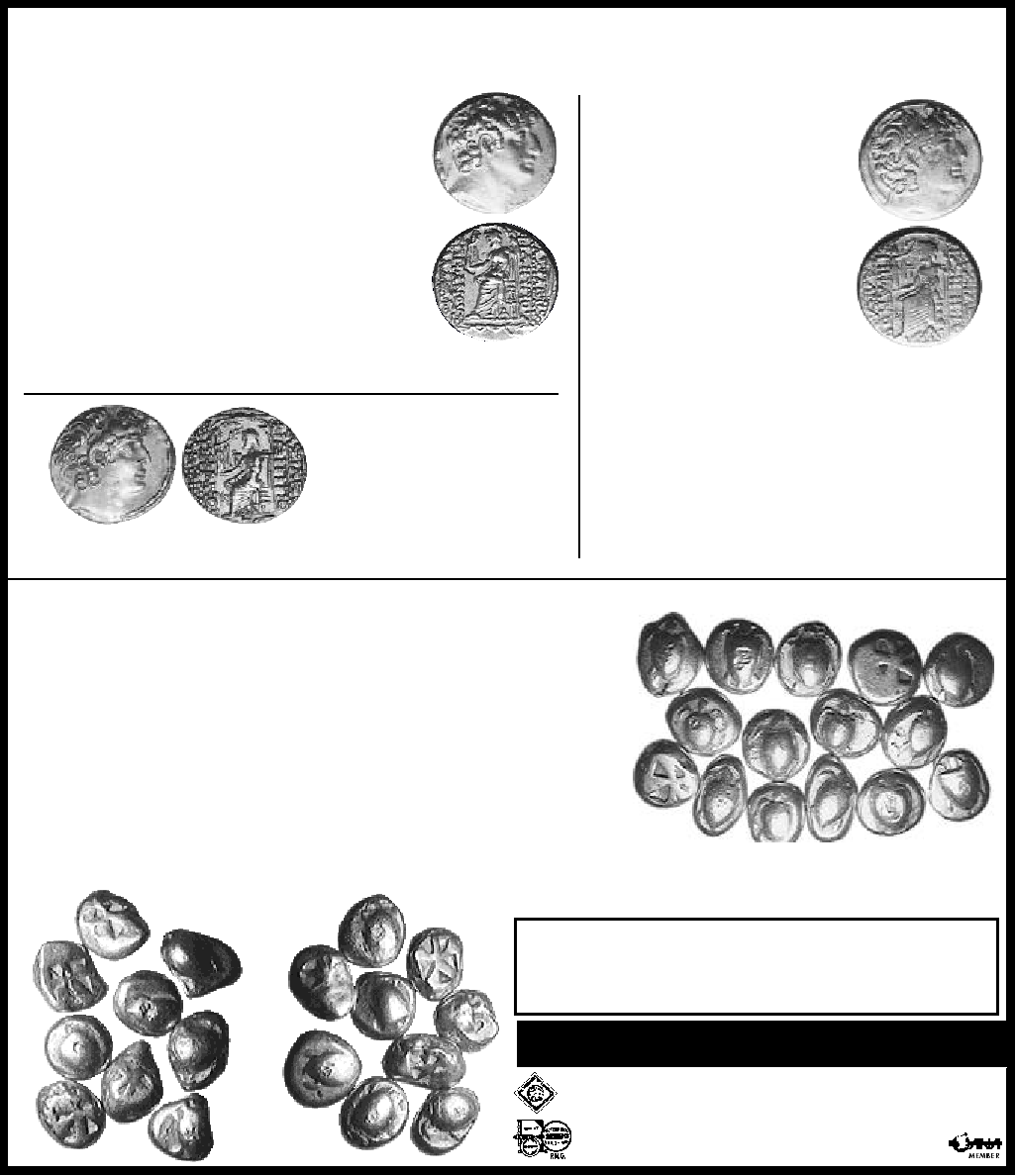
management was to change as little as possible. The last widely
acknowledged Greek Seleukid ruler of Antioch was Philip Philadelphos,
93-83 B.C. After Pompey the Great conquered the last of the Greek
armies, and absorbed Syria and Antioch into the Roman world, he
continued to strike silver Tetradrachms with the same design as Philip
Philadelphos, with only the added initials or monograms of the various
local Roman governors. The issue for Julius Caesar and his supporters
use 49 B.C. as the beginning of the Caesarian era. In 48 B.C. after Julius
defeated Pompey the Great, he spent 9 days in Antioch dedicating public
buildings and granting the city its "freedom." Antioch was still ruled by the
Romans, but it was allowed more discretion in municipal affairs. Julius
began striking these Tetradrachms in 47 B.C. and the issues continued
down to 37 B.C. when Mark Anthony and Cleopatra issued in their own
names.
silver. EF $127. VF $97. Fine $77.
75% fine silver, struck 47 to 37 B.C.
sell for: bold FINE for $67. Ve r y
Fine $97. EF for $177., and $347.
in Abt. Unc. with the largest flan. A
year 6 or 44/43 B.C. is $197. in EF.
Anthony and Cleopatra in 31 B.C. he revived
the issue of Philip style Tetradrachms. These
issues he continued down to at least 17 B.C.
The Antioch silver issues were very large
and they circulated heavily in the East.
Several scholars had suggested that this
coin could have been the type of the T h i r t y
Pieces of Silver, see Moneys of the Bible,
page 17 and 26. The wording of the Jewish
law regarding the temple dues makes it
mu ch mo re likely that th ese A n t i o c h
tetradrach ms wer e the type of coins
presented to the money changers in the
temple. After the percentages were extracted
by these foreign exchange merchants, the
faithful male Jew would have the appropriate
"good Tyrian silver" with which to pay his
dues to the temple treasury.
Philip Philadelpos on the obverse, wearing a
diadem, the symbol of Greek kingship. The reverse Zeus (Greek) or
Jupiter (Roman name) enthroned, holding a wreath presenting Nike
(Greek) or Victory (Roman name), and a sceptre. The legends still read
"Philip Philadelphos, the enlightened king." In front of Jupiter's leg is a
monogram of A N T for Antioch. The key to the different eras is in the
construction of the throne of Zeus on the reverse. The Augustan issue
has a triangle built into the back legs of the throne, while the earlier
issue has elliptical decorations.
each in Very Fine.
European Greece. On the obverse of these staters was a sea turtle, hence the popular term for these heavy chunks of silver. Not only
do these coins have a turtle depicted on the obverse of the coin, but the actual coins resemble a turtle. There is the high mounded
obverse, or back of the turtle, the skew pattern reverse that looks like the armored belly of the reptile, and they usually are struck out
of round, with various appendages which look like the legs and heads of the turtle. The sea turtle was an appropriate civic symbol for
Greeks who acquired their wealth as seafaring traders. The reverse design was a deeply punched incuse square divided
geometrically into segments, frequently triangles, and labeled "mill sail", "skew pattern" or "Union Jack", after the English flag design.
The weight of the staters was the very heavy Aiginetic standard of 12.6 grams of near pure silver, popular during the Archaic period in
Greece and Asia Minor. These staters of the earliest period, 550 to 480 B.C. were especially popular in ancient trade, and remained in
circulation until at least the 300s B.C. The Aiginetan turtles have turned up in ancient coin hoards as far east as Afghanistan, on the
overland trade route to the far east. Given their wide circulation, well worn examples usually have banker's marks to attest to their
solid silver content. The production of these sea turtles ceased when the island of Aigina fell to the Athenians in 456 B.C.
again. While they last:
American Express accepted.
5. All coins sent insured or registered! Orders less than